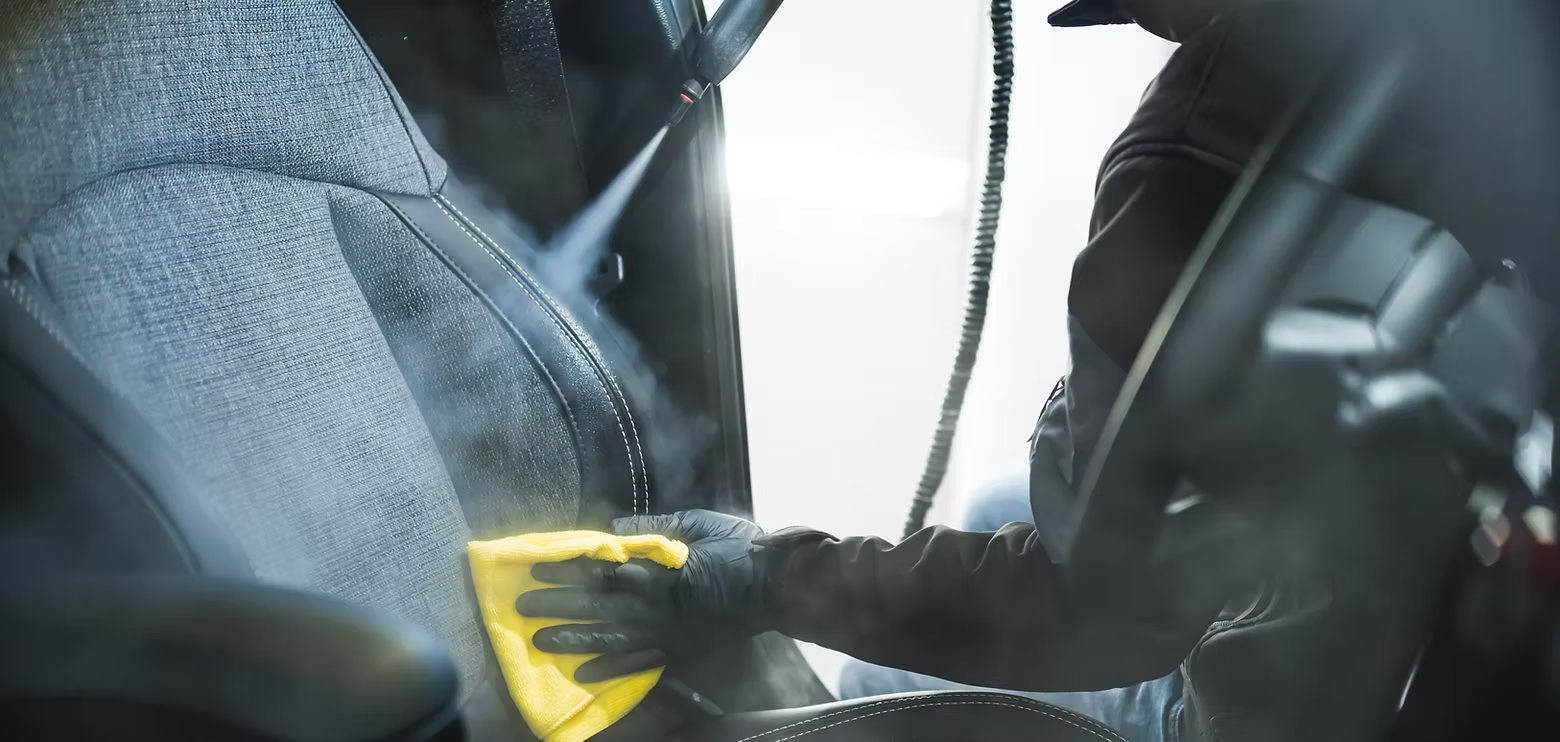Complete Guide to Car Odor Elimination: Remove Any Smell Permanently

Car odors can transform your driving experience from pleasant to unbearable. Whether it's lingering pet smells, stubborn smoke odor, musty mold, or mysterious food smells, vehicle odors are more than just unpleasant—they can affect your health, reduce your car's value, and make every drive uncomfortable. This comprehensive guide covers everything you need to know about professional car odor elimination, from understanding odor sources to permanent removal techniques.
Understanding Car Odors: Why They're So Persistent
Vehicle odors are challenging to eliminate because they don't just sit on surfaces—they penetrate deep into porous materials throughout your car. Understanding how odors work is the first step to permanent elimination.
How Odors Become Embedded
Odor molecules are volatile organic compounds (VOCs) that become trapped in:
- Upholstery foam and fabric fibers
- Carpet padding beneath floor mats
- Headliner material
- Door panel insulation
- HVAC system components (evaporator core, ducts, blower motor)
- Sound deadening materials
- Trunk carpeting and spare tire well
These materials act like sponges, absorbing and holding odor molecules. As temperature and humidity fluctuate, the materials release these molecules back into the air, causing the smell to persist or even intensify. This is why air fresheners only provide temporary masking—they don't address the source of the odor.
Common Types of Car Odors and Their Sources
Different odors require different elimination approaches. Here are the most common vehicle odors and what causes them:
1. Pet Odors
Pet odors come from multiple sources: dander, saliva, urine, and natural oils in fur. These organic compounds penetrate upholstery and carpets, creating persistent smells that intensify with heat and humidity. Pet urine is particularly challenging because it contains uric acid crystals that bond to surfaces and continuously release odor.
Severity: Moderate to severe, depending on frequency of pet transport and whether accidents occurred.
2. Smoke Odor (Cigarettes, Cigars, Vaping)
Smoke contains thousands of chemical compounds that bond to every surface in your vehicle. Tar and nicotine create a sticky film on windows, dashboard, and upholstery. Smoke particles penetrate deep into foam, insulation, and HVAC components. The smell is particularly stubborn because these particles continuously off-gas.
Severity: Severe. Smoke odor is one of the most difficult to eliminate and significantly reduces vehicle value.
3. Mold and Mildew
Mold grows in damp environments, often from water leaks, spills, or high humidity. Common locations include under floor mats, in the trunk, and in the HVAC system. Mold produces a musty, earthy smell and can cause health issues including allergies and respiratory problems.
Severity: Moderate to severe. Requires addressing moisture source and killing mold spores, not just masking the smell.
4. Food and Beverage Odors
Spilled drinks, forgotten food, and fast food residue create organic odors that attract bacteria. Milk spills are particularly notorious for creating unbearable smells as they decompose. Food particles can fall into crevices and under seats, decomposing over time.
Severity: Mild to severe, depending on the substance and how long it's been present.
5. Vomit
Vomit contains stomach acids and partially digested food that penetrate deep into upholstery and carpet padding. The smell is intense and can trigger nausea. If not properly cleaned, vomit odor can persist indefinitely.
Severity: Severe. Requires immediate professional treatment for complete removal.
6. Gasoline and Chemical Odors
Spilled gasoline, oil, or other chemicals create strong, potentially harmful odors. These petroleum-based compounds can be absorbed by carpets and upholstery, creating long-lasting smells.
Severity: Moderate to severe. May require specialized cleaning agents and ventilation.
7. Body Odor and Sweat
Regular use, especially in hot climates, causes sweat and body oils to accumulate in seats and steering wheel. Bacteria feed on these organic compounds, creating unpleasant odors.
Severity: Mild to moderate. Usually responds well to deep cleaning and sanitization.
Professional Car Odor Elimination Process
Professional car odor elimination follows a systematic approach that addresses both the source and the symptoms of odors:
Step 1: Odor Source Identification
Technicians begin by identifying the odor source and affected areas. This includes:
- Visual inspection for stains, spills, or visible contamination
- Checking under floor mats and seats for hidden problems
- Inspecting the trunk and spare tire area
- Testing the HVAC system for musty or moldy smells
- Using UV lights to detect pet urine (which fluoresces under UV)
Identifying the source is critical because different odors require different treatment approaches.
Step 2: Physical Removal of Contamination
Before treating odors, technicians remove any physical contamination:
- Thorough vacuuming of all surfaces, crevices, and under seats
- Removing and cleaning floor mats separately
- Extracting visible stains and spills
- Cleaning air vents and visible HVAC components
- Wiping down all hard surfaces
Step 3: Deep Steam Cleaning
Professional steam cleaning is essential for odor elimination because high-temperature steam (200-250°F):
- Penetrates deep into upholstery foam and carpet padding
- Kills bacteria, mold, and other odor-causing microorganisms
- Breaks down and lifts organic compounds that cause odors
- Sanitizes surfaces without harsh chemicals
- Reaches areas that manual cleaning can't access
Steam cleaning is particularly effective for pet odors, body odor, and mold because it addresses both the odor source and sanitizes the area.
Step 4: Enzyme Treatment
For organic odors (pet urine, vomit, food spills), enzyme-based cleaners are applied. These specialized products contain beneficial bacteria that literally eat the organic compounds causing the odor. Enzymes work at the molecular level to break down:
- Proteins from pet accidents and vomit
- Uric acid crystals from pet urine
- Organic compounds from food and beverage spills
- Body oils and sweat residue
Enzyme treatments require time to work—typically 30 minutes to several hours depending on contamination severity. The enzymes continue working even after application, providing ongoing odor elimination.
Step 5: Hot Water Extraction
After steam cleaning and enzyme treatment, professional carpet extractors remove loosened contaminants along with excess moisture. This powerful extraction:
- Physically removes odor-causing compounds from deep within materials
- Extracts cleaning solutions and dissolved contaminants
- Reduces drying time to prevent mold growth
- Flushes out particles that vacuuming can't reach
Step 6: Ozone Shock Treatment
Ozone treatment is the most powerful method for permanent odor elimination. Ozone (O₃) is a highly reactive molecule that destroys odor-causing compounds at the molecular level rather than masking them.
How Ozone Treatment Works:
- The vehicle is sealed with windows and doors closed
- An ozone generator is placed inside the vehicle
- The HVAC system runs on recirculate to treat air ducts
- Ozone gas fills the entire cabin, penetrating every surface and crevice
- Ozone molecules oxidize and neutralize odor compounds
- Treatment duration: 1-8 hours depending on odor severity
- After treatment, the vehicle is ventilated for 30+ minutes
Ozone treatment is incredibly effective because the gas reaches areas that manual cleaning cannot, including inside dashboard components, behind panels, throughout the HVAC system, and deep within upholstery foam. It eliminates smoke odor, pet odors, mold, and virtually any organic smell.
Step 7: HVAC System Treatment
The vehicle's HVAC system is often the primary source of persistent odors. Professional treatment includes:
- Replacing the cabin air filter (which traps odor particles)
- Applying antimicrobial foggers through the air intake
- Running ozone treatment with HVAC on recirculate
- In severe cases, accessing and cleaning the evaporator core
- Treating all air vents and ductwork
If the HVAC system isn't treated, it will continue releasing odors every time the system runs, undoing all other cleaning efforts.
Step 8: Final Sanitization and Protection
After odor elimination, technicians apply protective treatments:
- Antimicrobial treatments to prevent future bacterial growth
- Fabric protectants to make surfaces easier to clean
- Conditioning treatments for leather and vinyl
- Optional: Long-lasting odor neutralizers for ongoing freshness
Why DIY Odor Removal Methods Often Fail
Many vehicle owners attempt DIY odor removal with limited success. Here's why common methods fall short:
Air Fresheners and Sprays
Air fresheners only mask odors temporarily. They add fragrance to the air but don't eliminate the source of the smell. Once the fragrance fades, the original odor returns. In some cases, mixing fragrances with existing odors creates an even worse smell.
Baking Soda
While baking soda can absorb some surface odors, it can't penetrate deep into upholstery foam or carpet padding where odors are embedded. It's also difficult to completely remove from carpets, potentially leaving residue.
Household Cleaners
General household cleaners aren't formulated for automotive materials and may damage upholstery or leave residue. They also lack the specialized enzymes needed to break down organic odor compounds.
Consumer-Grade Ozone Generators
Small ozone generators sold for home use typically don't produce enough ozone for effective vehicle treatment. Professional generators produce much higher concentrations and are calibrated for proper treatment duration.
How Long Does Professional Odor Elimination Take?
Treatment time depends on odor severity and type:
- Light odors (body odor, mild food smells): 2-4 hours including cleaning and sanitization
- Moderate odors (pet odors, light smoke): 4-6 hours with enzyme treatment and ozone
- Severe odors (heavy smoke, pet urine, vomit): 6-8+ hours with multiple treatments
- Extreme cases (flood damage, severe mold): May require multiple days and component removal
Preventing Future Car Odors
After professional odor elimination, maintain a fresh interior with these tips:
- Address spills immediately before they set in
- Use seat covers and floor mats to protect surfaces
- Never leave food or beverages in the vehicle overnight
- Ventilate regularly by opening windows
- Replace cabin air filters every 12,000 miles or annually
- For pet transport, use waterproof seat covers and clean regularly
- Schedule professional interior cleaning every 6-12 months
- Fix water leaks immediately to prevent mold growth
- Don't smoke in the vehicle
The Health Benefits of Odor Elimination
Professional car odor elimination isn't just about comfort—it's about health:
- Removes allergens: Pet dander, mold spores, and dust mites that trigger allergies
- Eliminates bacteria: Harmful microorganisms that cause illness
- Reduces respiratory irritation: Especially important for smoke and mold odors
- Improves air quality: Creates a healthier environment for you and passengers
- Reduces stress: Pleasant environment improves mood and reduces driving stress
Impact on Vehicle Value
Odors significantly impact vehicle resale value. Studies show that vehicles with smoke odor sell for $2,000-$5,000 less than comparable odor-free vehicles. Pet odors and other persistent smells also reduce value and make vehicles harder to sell. Professional odor elimination is an investment that protects your vehicle's worth.
Eliminate Car Odors Permanently with Professional Service
Don't settle for temporary solutions or lingering odors. Our professional car odor elimination service uses advanced techniques including steam cleaning, enzyme treatment, and ozone shock treatment to permanently remove any odor from your vehicle. We bring professional-grade equipment directly to your location in Houston, Austin, and Dallas-Fort Worth for convenient, effective service. Get your fresh, clean interior back today.
Schedule Odor Elimination